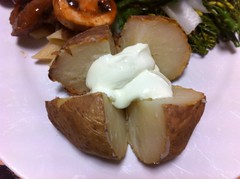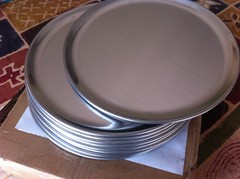 |
| Firing the Oven |
Apparently it is important to dry out the clay thoroughly at low temperatures gradually increasing to pizza-cooking temperatures. Thanks to 'david s' at the
Forno Bravo forums, I now know why the top layer of clay formed cracks. Scary cracks. I once had a crack on my windscreen that started small. Eventually the windscreen needed to be replaced. And the cracks in the windscreen were nothing on the cracks in the oven.
 |
| The Crack, Not Big Enough for a Matchstick |
I sort of went through a process of firing the oven - after the first fire, I set fires a few more times. And the crack continued to grow.
 |
| Crack a Week Later, With Matchstick |
For Mark II, apparently firing (also known as 'curing') the oven properly involves paper fires, then briquette (heat bead) fires, then stick fires, then log fires. David s suggested 20 kilograms of briquettes. This might be 10 times the 10 or so hours I had in fires. Also, my enthusiasm for fire overtook caution, so my fires started pretty big. Firing can be accompanied by weeks of air drying. It did take about 3 weeks to work up to pizzas, but mostly due to a temporary loss of confidence (in proportion with the growth of the crack).
 |
| Spuds in Foil Among the Coals |
Another alternative may be to dry each layer in turn. I wondered why
Simon Brookes emptied out sand and fired the first layer. I did not have confidence that the first layer would stand up. Hence the need to add more layers before emptying the sand.
 |
| Spuds Ready For Eating |
Along the way I tried to cook a couple of french sticks, which failed due to insufficient heat. I rescued them in sufficient time to put them in the inside oven and cook them successfully, but this was a failure for the oven. Later that day, after a lot more briquettes, I roasted whole potatoes in foil to great success.
...Geoff (still) the pyro
 |
| Shiny 9-inch Pizza Trays |
At about this time I also took delivery of a dozen shiny 9-inch aluminium pizza trays.






This comment has been removed by the author.
ReplyDelete